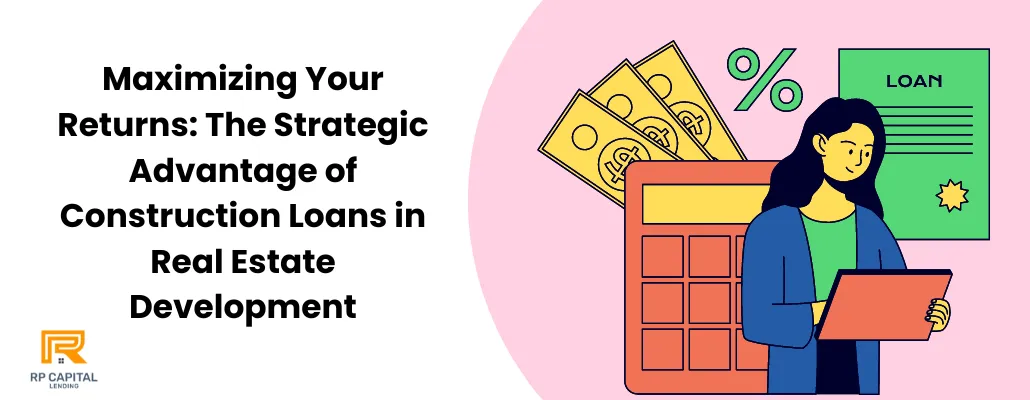Blog

Maximizing Your Returns: The Strategic Advantage of Construction Loans in Real Estate Development
In the world of real estate, the path to profitability is paved with smart decisions, strategic planning, and an unerring eye for opportunities. At the heart of many successful real estate ventures lies a not-so-secret weapon: construction loans. These financial instruments are not just the lifelines for projects under development; they are pivotal in maximizing return on investment (ROI) for savvy investors.
The Golden Key to Unlocking Potential: Understanding Construction Loans
Before we delve into the mechanics of maximizing ROI with construction loans, let's first understand what they are. Construction loans are short-term, high-interest loans that cover the cost of building or renovating properties.
Unlike traditional mortgages, they are disbursed in stages as the construction progresses, aligning with the project's needs and milestones.
1. Leverage: Amplifying Your Investment Reach
Construction loans offer a significant advantage: leverage. By using borrowed capital to fund a project, investors can engage in larger projects than they might otherwise afford, amplifying potential returns without tying up vast amounts of personal or business capital.
2. Flexibility: Tailoring to Project Needs
These loans are inherently flexible. Lenders often allow adjustments based on project progress and unforeseen needs, providing a cushion that can be vital for project completion. This flexibility can be a lifeline during unexpected challenges.
3. Speed: Fast-Tracking Development Projects
Speed is of the essence in real estate, and construction loans deliver. By ensuring that funding is available exactly when needed, these loans can accelerate project timelines, allowing investors to complete and sell or rent properties faster, thus realizing profits more quickly.
The Strategic Playbook: Maximizing ROI with Construction Loans
- Thorough Planning and Budgeting
Success begins with meticulous planning. A detailed project plan and budget, vetted by professionals, can prevent cost overruns and delays, ensuring that the loan serves its purpose without becoming a financial pitfall.
- Leveraging Industry Relationships
Building strong relationships with contractors, architects, and lenders can lead to better terms, lower costs, and smoother project execution. These partnerships are invaluable for successful real estate ventures.
- Understanding Market Dynamics
Market research is crucial. Understanding current trends and future projections can guide the project's direction, ensuring it meets market demand upon completion. This alignment with market needs is critical for maximizing returns.
Strategic Financial Planning: The Cornerstone of Success
The utilization of construction loans demands a level of financial acumen that goes beyond basic budgeting. Here's how strategic financial planning plays a crucial role:
- Interest Reserve Accounts
An often overlooked but critical aspect of managing a construction loan is the establishment of an interest reserve account. This account is used to make interest payments on the loan during the construction phase, thus preventing the need to service debt out of pocket before the project generates income. Smart planning for interest reserves can alleviate financial pressure and ensure project liquidity.
- Draw Schedules and Cash Flow Management
Effective cash flow management hinges on optimizing the loan's draw schedule—the plan for when and how loan funds are disbursed. Aligning the draw schedule with project milestones ensures that funds are available exactly when needed, reducing the cost of borrowing and enhancing project efficiency.
Risk Management: Safeguarding Your Investment
With high potential returns comes associated risks. Here's how to mitigate them:
- Contingency Funds
Including a contingency fund in the project budget can provide a buffer against unforeseen expenses, reducing the risk of project stalls due to budget shortfalls. Industry standards suggest a contingency of 5-10% of the total project cost, depending on the project's complexity and risk profile.
- Fixed-Rate Locks
Where possible, securing a fixed interest rate for the loan can protect against market fluctuations, ensuring that borrowing costs remain predictable and manageable throughout the construction period.
Legal and Regulatory Compliance: Building on Solid Ground
Understanding and adhering to local building codes and regulations is paramount. Non-compliance can lead to costly delays, fines, or even project cessation. Engaging with legal experts and local authorities early in the project can help navigate these complexities.
Sustainable and Green Building Practices: The Future of Development
Incorporating sustainable building practices and materials can not only reduce environmental impact but also increase the market appeal and long-term value of the property. Many lenders are increasingly supportive of eco-friendly projects, sometimes offering more favorable loan terms for such initiatives.
Advanced Technologies: The Edge in Construction Management
Leveraging advanced technologies like Building Information Modeling (BIM), drones for site surveying, and project management software can enhance efficiency, accuracy, and oversight in construction projects. These tools can lead to cost savings, improved timelines, and better risk management—factors that positively impact ROI.
Navigating the Path: FAQs on Construction Loans and ROI
Q1: How do construction loans differ from traditional mortgages?
Construction loans are short-term, cover construction or renovation costs, and are disbursed in stages. Traditional mortgages are long-term and disbursed in a lump sum to purchase a property.
Q2: Can construction loans cover the cost of land?
Yes, many construction loans can include the cost of purchasing land as part of the loan package, consolidating expenses into a single financing solution.
Q3: What are the risks associated with construction loans?
The primary risks include cost overruns, project delays, and market downturns. Effective planning and budget management are essential to mitigate these risks.
Q4: How can I ensure my project is a good candidate for a construction loan?
Projects with clear, detailed plans, strong budgeting, and a solid understanding of market demand tend to be more attractive to lenders, increasing the chances of loan approval.
Q5: What happens if the project goes over budget?
If a project goes over budget, the borrower might need to seek additional funding, either through renegotiating the loan or securing additional financing, emphasizing the importance of accurate budget forecasts.
The Bottom Line
Construction loans are more than just a means to an end; they are a strategic tool in the real estate developer's arsenal. By understanding how to leverage these loans effectively, investors can significantly enhance the profitability of their real estate ventures.
The key to success lies in diligent planning, market understanding, and strategic financial management, turning potential into profits through the savvy use of construction loans.
By navigating the intricacies of construction loans with an informed and strategic approach, real estate investors can unlock new levels of profitability, making the most of every opportunity in the dynamic landscape of real estate development.
RP Capital Lending is a d.b.a of RP Capital Partners Inc (NMLS # 2469193) | Privacy Policy
Copyright © 2022. All Rights Reserved.
Disclaimer: Loans only apply to non-owner occupied properties. Rates, terms and conditions offered only to qualified borrowers, may vary upon loan product, deal structure, other applicable considerations, and are subject to change at any time without notice.

